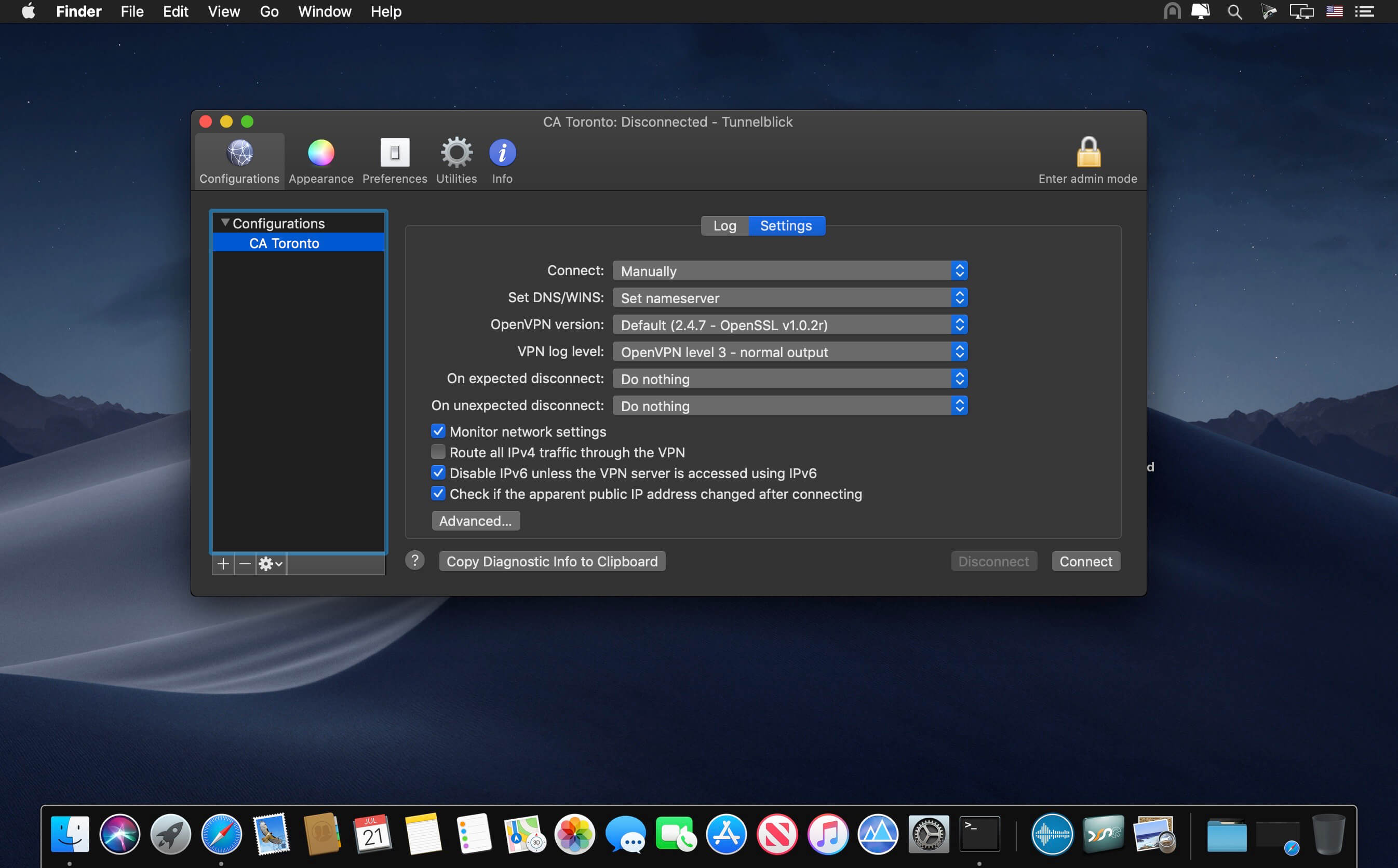
Tunnelblick is an OpenVPN client for macOS (OS X) to connect to the Big Data Lab VPN and the Cyber Range VPN.This guide shows you how to install Tunnelblick and connect to the Big Data Lab VPN. Vpn client download - Tunnelblick 3.8.2 B5480 download free - OpenVPN GUI for Mac OS X - free. software downloads - best software, shareware, demo and trialware.
Tunnelblick Windows Download
Highlighted Articles Discussion Group | On This Page The Tunnelblick ApplicationThe Tunnelblick application, Tunnelblick.app, must be stored directly in /Applications on the startup volume for security reasons. Thus it cannot be used from network drives or internal or external drives including thumb or flash drives, CD/DVD drives, etc. unless they are being used as the startup volume. Running Tunnelblick from from anywhere except /Applications on the startup volume will result in an offer to install Tunnelblick in /Applications on the startup volume. OpenVPN, Drivers, and Standard ScriptsThe OpenVPN program, openvpn-down-root.so, the 'tun' and 'tap' kext driver files, and standard client up/down scripts are included with, and contained within, Tunnelblick.app. Log FilesLog files are stored in /Library/Application Support/Tunnelblick/Logs. (Early versions of Tunnelblick stored them in /tmp/tunnelblick). The log files for a configuration are created or deleted and recreated each time the connection is made. There are two log files for each configuration, an OpenVPN log file and a scripts log file. The contents of the files are merged in the display in Tunnelblick's 'VPN Details' window. Key and Certificate FilesThese may be stored anywhere, but typically they are stored in the same folder as the configuration (.ovpn or .conf) file. Key and certificate files associated with a Tunnelblick VPN Configuration (.tblk) are stored inside the configuration itself. Key and certificate files usually have an extension of .cer, .crt, .der, .key, .p12, .p7b, .p7c, .pem, or .pfx. Configuration FilesThere are two types of configuration files:
Note: Configurations should always be installed by dropping them on the Tunnelblick icon in the menu bar. If you just move or copy them they may not work properly. There are five places configuration files may be stored:
Note: Prior to Tunnelblick version 3.0b24, private configuration files were stored in ~/Library/openvpn. Version 3.0b24 and later versions automatically move that folder to its new location, and replace it with a symbolic link to the new location. Custom ScriptsThere are two types of custom scripts that can be run at certain points in the connect/disconnect process:
These scripts should be located in a Tunnelblick VPN Configurations without any folder structure, and references to them should not contain any path information. For more information, see Using Scripts. LaunchDaemonsDurring installation, Tunnelblick sets up a 'daemon' to perform privileged operations such as starting OpenVPN as root. The daemon has a .plist file named net.tunnelblick.tunnelblick.tunnelblickd.plist in /Library/LaunchDaemons. If a configuration is set to connect when the computer starts, it has a .plist file located in /Library/LaunchDaemons. These .plist files are all named starting with 'net.tunnelblick.startup.' PreferencesA user's Tunnelblick preferences are contained in Note: In Tunnelblick 3.2beta10 and earlier, preferences are stored in Deployed versions of Tunnelblick may contain a 'forced-preferences.plist' file within the Tunnelblick application itself. They are used to override the user's normal preferences; see Deploying Tunnelblick for details. Tunnelblick VPN Configurations may also include preference defaults, which are used to initialize the user's preferences (which may then be changed by the user). One More ThingUnder certain circumstances, Tunnelblick replaces the configuration folder that very old versions of Tunnelblick use, |
Tunnelblick For Ios
Tunnelblick helps you control OpenVPN® VPNs on macOS. It is Free Software that puts its users first. There are no ads, no affiliate marketers, no tracking — we don't even keep logs of your IP address or other information. We just supply open technology for fast, easy, private, and secure control of VPNs. Tunnelblick comes as a ready-to-use application with all necessary binaries and drivers (including OpenVPN, easy-rsa, and tun/tap drivers). No additional installation is necessary — just add your OpenVPN configuration and encryption information. To use Tunnelblick you need access to a VPN server: your computer is one end of the tunnel and the VPN server is the other end. For more information, see Getting VPN Service. Tunnelblick is licensed under the GNU General Public License, version 2 and may be distributed only in accordance with the terms of that license. OpenVPN is a registered trademark of OpenVPN Inc. |
